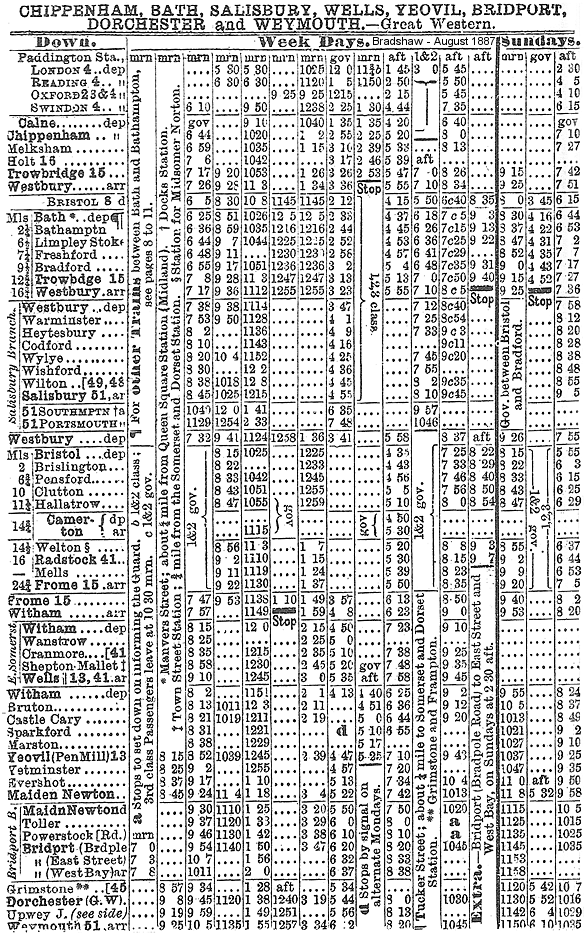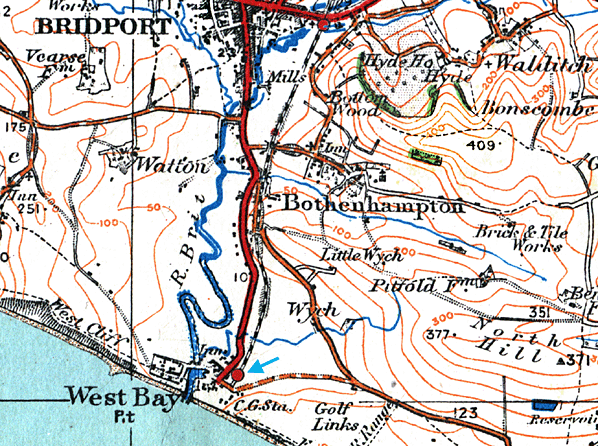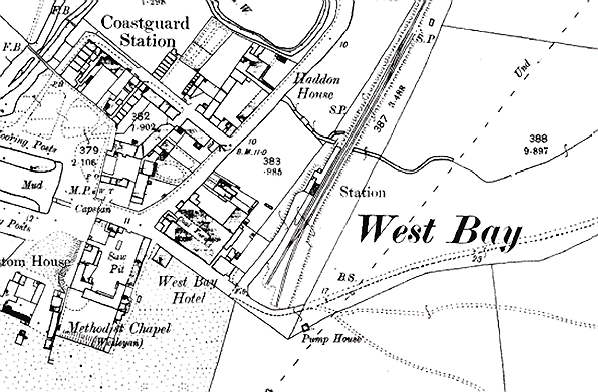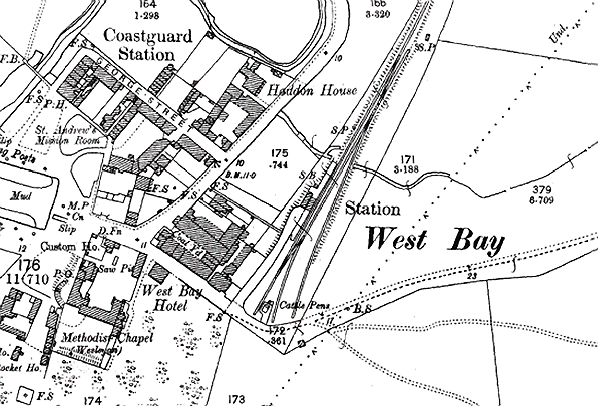|
Notes: West Bay station opened to serve Bridport Harbour, with plans for the location to be developed into a significant holiday destination. It had the simple layout of a small terminus, with a single passenger platform (on the up side, west of the track), a run-round loop, cattle pens and a couple of goods sidings. The building was a neat, limestone structure with a ridged, slate roof with deep eaves, and shapely chimney stacks. A small wooden awning with deep, incised valances, was supported by curved brackets with scroll infills. By 1902 a signal box was added just north of the station building.
West Bay failed to fulfil expectations as a tourist resort, and the line from Bridport (Bradpole Road) to West Bay closed to passengers in 1930, but the station remained intact even after goods services ceased in December 1962.
The platform and station building survive, restored and extremely attractive, with ‘heritage’ lighting on the platform and a length of track. It has had various uses since closure. In the early 1970s the station building was used as an office for a local boat yard. After the boat yard moved out in the 1980s the station was boarded up and deteriorated quickly. By 1994 it was in such a poor condition that concern was expressed about its future. The station was purchased by West Dorset District Council and restoration work on the station building began in late 1994. The Swanage Railway won a tender to lay four panels of track beside the platform. This work started on 27 February 1995. A stop block and a GWR tubular starting signal were also to be added.
Two coaches were leased from the Swanage Railway and arrived on site in March 1995; a former LSWR ironclad No 728 and BR Mk 1 TSO No 4070. In Easter 1996 the station became an exhibition area and information centre for the West Bay Coastal Defence and Harbour Improvement Scheme. The two coaches were refurbished for use by the project's design team.
During the summer of 1998 the station was taken over by a film company for the filming of TV drama series ‘Harbour Lights’.
From 2001 – 2001 the station housed the Tourist Information Centre before its move to The Salt House in West Bay. By 2003 the two coaches had been removed.
From then on the site has been used for cafes/restaurants by various people. In 2005 another two carriages were brought to West Bay by the ‘Station Diner’ operator, Martin Jones, for use as dining cars. After the failure of the business they were removed in August 2008 to storage at a former military base at Long Marston. The station is now used as a tea shop trading as The 'Tea Station'.
BRIEF HISTORY OF THE MAIDEN NEWTON – BRIDPORT – WEST BAY BRANCH
A number of proposals were put forward in the 1840s to connect the small Dorset town of Bridport by railway to a main line. The Wiltshire, Somerset & Weymouth Railway was to run between Weymouth and Chippenham, passing through various towns, including Bridport. The Bristol & English Channel Railway would link Bridport with Stolford, near Bridgwater (Somerset). A further proposal was for a line from Bridport to Watchet, in Somerset, and there was also a plan for a line from Maiden Newton to Exeter via Bridport, Seaton and Honiton. However none of these schemes went ahead. Eventually the reluctance of main line companies to provide a link to Bridport encouraged a syndicate of Bridport residents to undertake the task themselves.
 |
A public meeting took place at Bridport Town Hall in late 1854, where the decision was taken build a branch line to Maiden Newton - which was to be served by the Weymouth to Westbury line which opened in 1857. The Bridport Railway Company was established, and it obtained legal status through an Act of 5 May 1855. Henry J Wylie was appointed |
Engineer, and Kenneth Mathieson was awarded the contract to build the 9¼ miles of railway at an estimated cost of £65,000: the work was expected to be complete by late 1856. On 19 June 1855 the first sod was cut by Joseph Gundry, company Chairman, at Loders between Powerstock and Bridport. However, difficulties with stabilising the earthworks along the route, particularly north-east of Powerstock, resulted in a year’s delay in completing the project. At Witherstone where the railway cut through the hills, a slippage occurred in a large cutting; one of the slips required purchase of extra land from a Mr Jenkins, in return for which a 50ft siding was provided for his use.
 |
The line was constructed with bridges which could accommodate only a single track. The ‘MacDonnell road system of Permanent Way’ was used, with rails mounted on longitudinal iron sleepers. The Great Western Railway (GWR) broad gauge of 7ft 0¼in was used, as on the Weymouth – Westbury line. (The branch was converted to 4ft 8½in standard gauge on 19-21 June 1874.) In May 1856, as a result of public pressure, the company decided to provide intermediate stations at Smokeham (Powerstock) and Toller, but they were to be built as cheaply as possible and closed if they proved unremunerative. Inhabitants of Loders requested a station, but their wishes were not granted. In October 1857 the Board of Trade Inspector, Captain identified features of the line’s engineering which required rectification. When these had been attended to the railway officially opened on 12 November 1857, the Board of Trade having authorised its use the previous day. The GWR operated the line with its own steam locomotives and rolling stock – and eventually bought the branch in July 1901.
| When the line opened the only intermediate station was Powerstock, whose name was ‘Poorstock’ in most sources (including GWR timetable and Bradshaw) until 1860. The station building was in the style of a cottage, which could be used as a dwelling if the station did not pay. On 31 March 1862 a further station was opened at Toller Porcorum – known, |
 |
simply, as Toller – and this was also an inexpensive structure. The intention was to provide a passing place at Powerstock but this was never installed, and, throughout the life of the branch, trains could cross only at the Toller goods loop, operated by a key on the electric train staff.
The early days of the railway were not without incident. On Boxing Day 1857 vandals placed iron rails across the track at Toller, and on 8 January 1858 a large boulder was dropped on the line at Bridport. On 14 April 1858 cash was stolen from Powerstock station while the stationmaster was at church. Within twelve months of opening another major landslip occurred at Witherstone, and drainage works were required to make the earthworks safe. Some 20,000 cubic yards of spoil had to be removed - but it was found to be suitable for brick-making and was sold at a profit.
DESCRIPTION OF THE ROUTE
After leaving Maiden Newton the Bridport branch crossed the River Frome and fell on a ruling gradient of 1 in 100, before climbing at 1 in 150/200 to Toller station. Beyond Toller the line rose at 1 in 85 across moorland to a board reading ‘All goods and mineral trains must stop dead here’. Beyond was a fall at 1 in 37 through a belt of woodland to Powerstock where it became level. Another stop board lay 70 yd beyond, following a ruling gradient of 1 in 52 down to Bridport, the last half mile following the River Brit.
 |
EXTENSION TO WEST BAY
Shortly after the opening of the branch the Bridport Company considered plans for its extension. In 1859 West Dorset Railway scheme would continue the line to Charmouth, and in 1860 there was a scheme for the Bridport, Lyme Regis & Axminster Railway. These were not proceeded with, and in 1863 a proposed line from Clapton Bridge (Crewkerne) to Bridport Harbour was opposed by the Bridport Company. The more modest decision was taken to extend the branch to the coast at Bridport Harbour, and on 21 July 1879 this was authorised by an Act of Parliament. The Bridport Company had authority to raise a capital of £42,000 and borrowing powers of £14,000. The GWR agreed to pay £12,000 towards the cost of construction. Mousley and Lovatt were chosen as the main contractors for the work which began in 1883.
| An intermediate station was built at East Street, Bridport, with the terminus at Bridport Harbour. Since the 1830s the prosperity of the harbour had collapsed with the decline of local flax and hemp growing - which had provided the cargo – and the closure of its shipyard. The GWR recognised the holiday potential of the coast and chose to call the terminus the more appealing name of 'West Bay'. The extension opened on 31 March 1884, when 5,100 passengers used the new line, including 1,100 Sunday school |
 |
children who were not allowed out of the train at West Bay owing to the inclement weather and were taken straight back to Bridport. Most of the railway’s directors formed the West Bay, Bridport, Land Building Co Ltd to develop a town at the terminus, with an esplanade, hotel and houses. As a result of this initiative The Neptune public house became The West Bay Hotel and Pier Terrace was built in 1886 as terraced holiday houses. Previously the GWR’s only foothold on the coast east of the River Exe was at Weymouth, and West Bay promised to strengthen the GWR presence on the Dorset coast. However, after a promising start, West Bay failed to develop into anything more than a large village.
PASSENGER SERVICE AND MOTIVE POWER
The original passenger service of five trains each way from Monday to Saturday took about 35 minutes to travel 11¼ miles; in the following month the service was reduced to four trains each way. In June 1865 five down and four up trains operated, with two each way on Sundays. In 1884 there were seven trains between Maiden Newton and Bridport, four continuing to West Bay. In 1938 eleven down and ten up trains ran, with six each way on Sundays.
At first the branch was worked by broad gauge 4-4-0STs including Theocritus and Hesiod. In 1862 Aries and Virgo ‘Leo’ class 2-4-0STs were used. ‘Victoria’ class 2-4-0 Brindley also appeared, though tender engines were rare. In standard gauge days 0-6-0STs were used. Around the turn of the century Nos 1304-7, 4-4-0Ts, built by the Monmouthshire Railway & Canal Company and 0-4-4Ts Nos 1708-10 (once owned by the same company) appeared, the latter rebuilt as saddle tanks. When these left early in the twentieth century they were replaced with GWR 0-6-0STs and, in due course, by 0-6-0PTs.
 |
Passenger services on the extension were withdrawn as a World War I economy measure on 1 January 1916, to be restored on 7 July 1919. The service ceased again on 11 April 1921 only to resume exactly two months later. On 24 September 1924 trains were withdrawn for the winter season but began once more after a fortnight, on 6 October. The volume of passenger traffic between Bridport and West Bay was disappointing, as the intended holiday destination had failed to become a serious rival to established south coast resorts, and visitors now preferred to arrive by motor bus or car. Passenger trains were finally withdrawn from 22 September 1930, but goods traffic continued to use the line. In 1935 a camping coach was installed at West Bay (and in 1936 another was placed at Powerstock). From 3 December 1962 goods services ceased between Bridport and West Bay, but on 25 August 1963 two GWR steam locomotives hauled a special passenger train on this section of line. Two years later the track was lifted.
On the Maiden Newton to Bridport section, on 4 November 1940 sidings at Bradpole and Loders were opened for anti-aircraft guns mounted on railway wagons. These were taken out of use on 22 April 1945. Also during World War II train loads of shingle were taken from West Bay for airfield construction. As to locomotives allocated to the Bridport branch, by June 1936 48XX class 0-4-2T No 4803 had appeared and 74XX class 0-6-0PTs arrived soon after. In 1941 45XX 2-6-2T No 5555 worked the branch.
NATIONALISATION AND CLOSURE
At Nationalisation on 1 January 1948, the Dorchester – Yeovil line and the Bridport branch were allocated to the Western Region. However on 2 April 1950 these routes were transferred to the Southern Region, which installed totems in its green livery at Maiden Newton, but not at the Bridport branch stations, perhaps implying that the branch was not expected to survive long. On 1 January 1963 all stations north of Dorchester West, including the Bridport branch, were restored to the Western Region, but no chocolate-and-cream signage is believed to have been given to the branch stations in this era.
 |
Diesel multiple units replaced steam traction on 15 June 1959; on the same day the single-road engine shed at Bridport closed. At first a 3-car DMU set was used, but later a single-car unit was found sufficient. In winter 1960-1 the down service (Maiden Newton – Bridport) consisted of ten trains on weekdays and 4 on Sundays. In the opposite |
direction, in addition to the ten weekday trains an extra late working on Thursdays and Saturdays left Bridport at 9.05 pm, and there were three trains on Sundays. Sunday services ceased in 1962. The DMU came daily from Weymouth, and when that shed closed in 1968, the working was covered by Westbury depot. If it lost its path on the single line and was late arriving, a taxi had to be substituted. Following the dieselisation of the passenger service, goods trains continued to be worked by 57XX class 0-6-0PTs and latterly Ivatt class 2 2-6-2Ts until this traffic ceased on 5 April 1965. From this date the branch was operated as a single line siding, the only signals being at Maiden Newton.
The Bridport branch was earmarked for closure in The Reshaping of British Railways (‘Beeching Report’). Formal publication of the proposal to withdraw passenger services took place on 7 October 1965, but on 1 June 1967 the Minister of Transport refused consent to the closure on the grounds of hardship that would be caused – the only criterion allowed for the rejection of the proposal. The railway route between Maiden Newton and Bridport was far more direct than that by the major road, and the intermediate settlements of Toller and Powerstock / Nettlecombe could be reached only by narrow, minor roads. A subsidy from Dorset County Council enabled the service to continue.
From 11 April 1966 Toller and Powerstock stations became unstaffed, platform lamps being sent from Maiden Newton daily, returned by the guard of the last passenger train of the day. At this time it was normally Western Region practice to add ‘Halt’ to station names when they became unstaffed, but the suffix was not given to Toller and Powerstock. Bridport station was unstaffed from 6 Oct 1969. The May 1974 timetable showed nine trains in each direction on the branch.
A further enquiry into the viability of the Bridport branch found that a suitable replacement bus service could be provided, and the final passenger trains ran on Saturday 3 May 1975, official closure taking place on Monday 5 May. Lifting of the tracks began on 18 November 1975. Shunter 08 636 was temporarily stabled at Maiden Newton for working the brake van and winch, bogie and roller wagons of the lifting train.
The junction station at Maiden Newton remains open to trains on the Heart of Wessex Line. Part of the Bridport / West Bay line can be enjoyed on foot and cycle from Maiden Newton station for about half a mile, and along parts of the old line past Toller Porcorum. Sustrans have funding to use the old line as a cycle path from Maiden Newton to Bridport.
Part of the trackbed between Bridport and West Bay is adopted by the A35 Bridport bypass (Sea Road South). The West Bay section between Burton Road and the station itself is a gravelled footpath which rises to meet Burton Road. The top of the bridge, bore entrance and track bed can still be identified. Towards the site of East Street station, the railway would have passed through Wanderwell and then east of the junction with Burton Road and West Bay Road. Sea Road North uses the former trackbed between East Street and Bradpole Road stations.
Tickets from Michael Stewart. Bradshaw and GWR timetable from Chris Totty. Route map drawn by Alan Young. Additional source Bridport Museum
Click here for a four minute film of the Bridport branch in 1975
Sources:
Further reading and viewing :
See also: Bridport East Street, Bridport (Bradpole Road), Powerstock, Toller & Maiden Newton |

bay_old16.jpg)



bay_old1.jpg)
bay_old5.jpg)
bay_old3.jpg)
bay_old14.jpg)
bay_old2.jpg)
bay_old7.jpg)
bay_old17.jpg) West Bay station c1964 after goods services had been withdrawn and the final excursion had visited the station. The trackbed has been invaded by weeds.
West Bay station c1964 after goods services had been withdrawn and the final excursion had visited the station. The trackbed has been invaded by weeds.bay24.jpg)
bay2.jpg)
bay9.jpg)
bay8.jpg)
 Home Page
Home Page 






